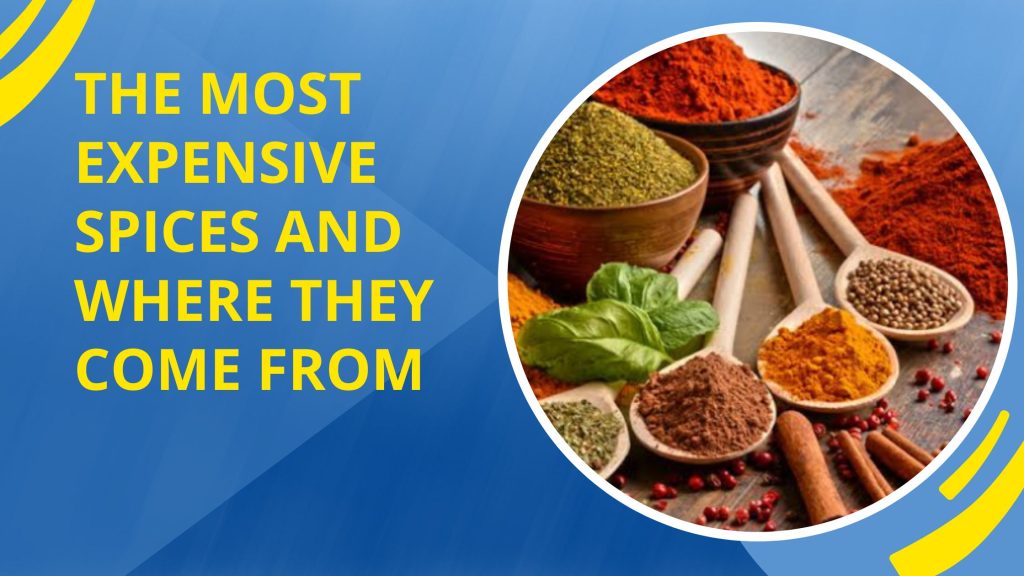Spices have played a pivotal role in shaping human history, influencing trade, economics, and even wars. Today, they hold a special place in culinary arts, elevating dishes with their distinctive flavors, vibrant colors, and alluring aromas. Among the hundreds of spices used globally, a select few are prized not only for their taste but also for their exceptional value. These are the world’s most expensive spices, cherished by foodies, gourmet cooks, and spice enthusiasts alike. This blog takes you on a flavorful journey, exploring the origins, cultivation, and significance of these culinary treasures.
The World’s Most Expensive Spices
Table of Contents
When it comes to luxurious ingredients, these spices reign supreme:
- Saffron – Often referred to as “red gold.”
- Vanilla – The second-most expensive spice globally, after saffron.
- Cardamom – Known as the “Queen of Spices.”
These spices command high prices due to their labor-intensive cultivation processes, rarity, and demand. Now, let’s take a closer look at why they are so cherished.
Saffron – The Red Gold of Spices
Origins and Cultivation
Saffron, derived from the stigmas of the crocus flower (Crocus sativus), is primarily grown in regions such as Iran (the largest producer), Spain, and Kashmir. Its cultivation is incredibly labor-intensive, as each flower produces only three red stigmas that are carefully handpicked. It takes about 75,000 blossoms to yield a single pound of saffron.
Processing and Price
After harvesting, the stigmas are delicately dried to preserve their flavor and aroma. This meticulous process and high demand result in saffron prices ranging between $500 to $5,000 per pound, making it the most expensive spice in the world.
Culinary Uses and Flavor
Saffron imparts a unique, earthy-sweet flavor and vibrant golden-yellow color to dishes. It is often used in gourmet cooking for recipes such as paella, risotto, biryanis, and bouillabaisse. A small pinch of saffron is all it takes to transform a dish into a luxurious experience.
Vanilla – The Second-Most Expensive Spice
Origins and Cultivation
Vanilla originates from the tropical regions of Central and South America and is now cultivated extensively in Madagascar, Mexico, and Tahiti. The vanilla orchid (Vanilla planifolia) requires hand pollination, a time-consuming and delicate process that adds to its cost.
Processing and Price
Once harvested, the vanilla pods undergo a lengthy curing process that can take up to six months to develop their signature aroma and flavor. High-quality vanilla can cost anywhere between $200 to $600 per pound, influenced by fluctuating weather and growing conditions.
Culinary Uses and Flavor
Vanilla is celebrated for its sweet, creamy flavor and exquisite aroma, making it a staple in both sweet and savory dishes. It’s used in everything from baked goods and desserts to sauces and beverages. Gourmet cooks value pure vanilla extract and beans for their nuanced flavors.
Cardamom – The Queen of Spices
Origins and Cultivation
Cardamom is native to the lush forests of the Western Ghats in India but is now also cultivated in Guatemala and Sri Lanka. The pods of this spice are harvested by hand, and processing happens quickly to prevent the seeds from losing flavor.
Processing and Price
Green cardamom, the most prized variety, is carefully dried to maximize its aroma and taste. Prices range from $30 to $100 per pound, depending on quality and origin.
Culinary Uses and Flavor
Cardamom’s warm, sweet-spicy flavor can elevate both savory dishes like curries and sweet treats like pastries. It is also a favorite in spiced teas, coffees, and even cocktails.
The Economic and Cultural Impact of Luxurious Spices
The cultivation and trade of these spices have a profound economic and cultural impact on the regions where they are grown. For instance:
- Saffron from Iran supports thousands of local farmers and is a symbol of Persian culture.
- Madagascar Vanilla accounts for 80% of the world’s vanilla production, significantly contributing to the country’s economy.
- Indian Cardamom is deeply embedded in Ayurveda and traditional Indian cooking, symbolizing health and prosperity.
These spices are more than culinary ingredients; they are a lifeline for communities, a cultural heritage, and a reflection of their regions’ unique natural resources.
Tips for Buying, Storing, and Using Expensive Spices
Given their value, it’s essential to handle these spices with care to preserve their quality and flavor. Here are some practical tips:
- Buying:
- Storing:
- Using:
- Use sparingly; a little goes a long way.
- Grind cardamom seeds fresh for maximum aroma.
- Infuse saffron in warm liquid before adding it to dishes for even distribution.
-
By following these tips, you can get the most out of your investment in these gourmet spices.
Elevate Your Culinary Adventures with the World’s Best Spices
The world of spices is as vast as it is enchanting, with each high-value spice offering a unique taste of its origin. Whether you’re creating a luxurious saffron risotto, a rich vanilla-infused dessert, or a fragrant cardamom chai, these spices promise to elevate your culinary creations to gourmet levels. They’re not just an indulgence—they’re an investment in flavor, culture, and tradition.
Curious to learn more about exploring gourmet cooking with premium spices? Sign up for our newsletter to access exclusive recipes, storage tips, and sourcing guides that help you make the most of these incredible ingredients.
